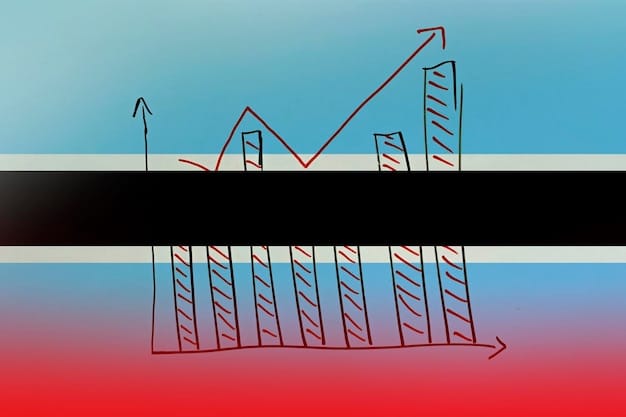Financial Planning: Save $50,000 in 3 Years for a Down Payment

Financial planning to save $50,000 in 3 years for a down payment involves setting clear goals, creating a detailed budget, automating savings, and exploring investment options, while adopting strategies to reduce expenses and increase income.
Planning to buy a home? Saving for a down payment, especially a significant amount like $50,000 in just three years, requires diligent financial planning. It might seem daunting, but with the right strategies and a disciplined approach, it’s achievable. This comprehensive guide will walk you through the steps to reach your goal.
Set a Clear Financial Goal
Before diving into saving strategies, it’s crucial to define your goal precisely. How much do you need for a down payment? Understanding the total cost and down payment requirements is essential.
Determine Your Down Payment Target
Research the housing market in your desired location. What’s the average home price? What percentage is typically required for a down payment? This research will give you a concrete number to work towards.
Calculate Your Monthly Savings Goal
Once you know your target down payment amount, divide it by 36 (the number of months in three years) to determine your monthly savings goal. This will give you a clear, actionable target to aim for each month.
Having a well-defined financial goal is the first step, providing you with a specific target and a clear understanding of the monthly savings required. With this foundation, you can move on to more detailed planning and budgeting.

Create a Detailed Budget
Budgeting is the backbone of any successful financial plan. A detailed budget helps you understand where your money is going and identify areas where you can cut back and save more.
Track Your Current Spending
Start by tracking your income and expenses for a month. Use a budgeting app, spreadsheet, or even a notebook to record every dollar you spend. This will provide a clear picture of your spending habits.
Identify Areas to Reduce Expenses
Once you have a clear view of your spending, look for areas where you can reduce expenses. This might include cutting back on dining out, entertainment, subscriptions, or other non-essential items.
- Dining Out: Reduce restaurant visits and cook more meals at home.
- Entertainment: Find free or low-cost entertainment options, such as hiking or visiting local parks.
- Subscriptions: Cancel unused subscriptions and negotiate lower rates for services you use regularly.
- Transportation: Consider biking, walking, or using public transportation instead of driving to save on gas and parking.
Creating a detailed budget is essential for understanding your current financial situation and identifying opportunities to save. By tracking your spending and reducing unnecessary expenses, you can free up more money to put towards your down payment goal.
Automate Your Savings
Automating your savings is a powerful strategy to ensure you consistently save money towards your down payment goal. Set up automatic transfers from your checking account to a dedicated savings account.
Set Up Automatic Transfers
Schedule automatic transfers from your checking account to a high-yield savings account each month. This ensures you consistently save without having to manually transfer funds.
Choose a High-Yield Savings Account
Look for a high-yield savings account that offers a competitive interest rate. This will help your savings grow faster over time. Compare rates and fees from different banks to find the best option.
Treat Savings Like a Bill
Consider your savings contribution as a non-negotiable bill that must be paid each month. This mindset can help you prioritize saving and stay on track with your financial goals.
Automating your savings simplifies the process and ensures you consistently contribute towards your down payment goal. By setting up automatic transfers and choosing a high-yield savings account, you can maximize your savings potential.

Explore Investment Options
While saving in a high-yield savings account is a good starting point, consider exploring investment options to potentially grow your money faster. However, it’s important to balance potential returns with risk.
Consider Low-Risk Investments
Look into low-risk investment options such as certificates of deposit (CDs) or money market accounts. These offer a relatively safe way to earn a higher return than a traditional savings account.
Consult a Financial Advisor
If you’re unsure about investing, consult a financial advisor who can help you assess your risk tolerance and recommend suitable investment options. They can provide personalized advice based on your financial situation and goals.
Exploring investment options can potentially accelerate your savings growth, but it’s crucial to balance potential returns with risk. By considering low-risk investments and consulting a financial advisor, you can make informed decisions that align with your goals.
Reduce Debt
High-interest debt can hinder your ability to save for a down payment. Prioritize paying down debt to free up more funds for savings. It’s a crucial aspect of smart financial planning.
Tackle High-Interest Debt First
Focus on paying down high-interest debt such as credit card balances or personal loans. The sooner you pay these off, the more money you’ll have available for savings.
Consider Debt Consolidation
Explore debt consolidation options such as balance transfers or personal loans to potentially lower your interest rates and make your debt more manageable.
Avoid Taking On New Debt
While you’re working on paying down debt, avoid taking on new debt unless absolutely necessary. This will help you stay on track with your savings goals.
Reducing debt is essential for freeing up more funds for savings. By tackling high-interest debt first, considering debt consolidation, and avoiding new debt, you can improve your financial situation and accelerate your progress towards your down payment goal.
Increase Your Income
Increasing your income can significantly boost your savings rate. Explore opportunities to earn extra money through side hustles, freelancing, or negotiating a raise at your current job.
Explore Side Hustles
Consider starting a side hustle to earn extra money. This could include freelancing, driving for a rideshare service, or selling handmade goods online. Find something that aligns with your skills and interests.
Negotiate a Raise
Research industry standards for your position and experience level. Prepare a strong case highlighting your accomplishments and contributions to the company, and confidently ask for a raise.
Increasing your income is a powerful way to accelerate your savings progress. By exploring side hustles and negotiating a raise, you can significantly boost your savings rate and reach your down payment goal faster.
With these strategies, saving $50,000 in three years for a down payment is achievable. Clear financial goals, budgeting, automated savings, smart investments, reducing debt, and increasing revenue all contribute to success.
| Key Point | Brief Description |
|---|---|
| 🎯 Set Clear Goals | Define the exact down payment amount needed. |
| 💰 Create a Budget | Track spending and identify areas to cut back. |
| ⚙️ Automate Savings | Set up automatic transfers to a savings account. |
| 📈 Reduce Debt | Pay down high-interest debt to free up savings. |
FAQ
▼
To save $50,000 in 3 years (36 months), you’ll need to save approximately $1,389 per month. This calculation doesn’t include potential interest earned, which could reduce the monthly savings amount needed.
▼
A high-yield savings account is generally best. It offers a higher interest rate compared to traditional savings accounts, allowing your savings to grow faster while keeping your money safe and accessible.
▼
Yes, many states and local governments offer down payment assistance programs. These programs can provide grants or low-interest loans to help eligible homebuyers cover their down payment costs. Research options in your area.
▼
Start by tracking your spending to identify areas where you’re overspending. Then, create a budget and set realistic limits for each category. Look for ways to cut back on non-essential expenses, like dining out or entertainment.
▼
Investing always carries some risk. The value of your investments could decrease, especially in the short term. It’s important to choose low-risk options and consider consulting a financial advisor before making any investment decisions.
Conclusion
Embarking on the journey to save $50,000 in three years for a down payment requires dedication and strategic financial planning. By setting clear goals, budgeting effectively, automating savings, exploring investment options, reducing debt, and increasing your income, you can achieve your dream of homeownership. Start planning today and take control of your future!





